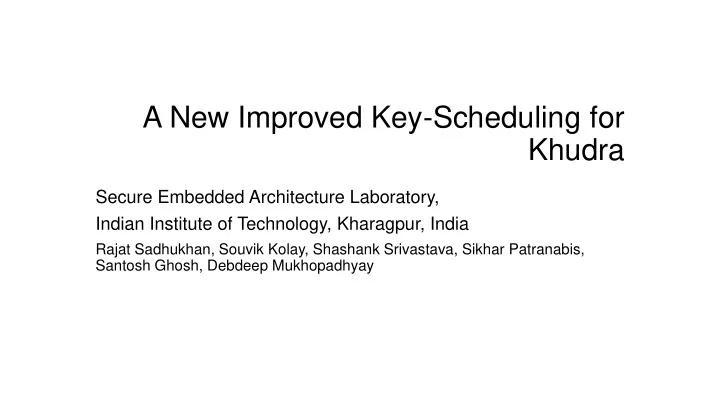

A New Improved Key-Scheduling for Khudra Secure Embedded Architecture Laboratory, Indian Institute of Technology, Kharagpur, India Rajat Sadhukhan, Souvik Kolay, Shashank Srivastava, Sikhar Patranabis, Santosh Ghosh, Debdeep Mukhopadhyay
Topics • Lightweight Block Cipher • Khudra – A case study for lightweight block cipher • Architecture of Khudra • Attacks on Khudra • Resistance against Attacks • Conclusion
• Motivation: Emerging growth of wearable technologies, pervasive devices, lightweight communication protocols • Aim: To provide adequate security with minimal hardware requirements constrained by area, power, and cost • Target application areas: Internet-of-Things (IoTs), battery powered wireless sensor networks (WSNs)
Topics • Lightweight Block Cipher • Khudra – A case study of lightweight block cipher • Architecture of Khudra • Attacks on Khudra • Resistance against Attacks • Conclusion
Khudra - Features • Lightweight Block Cipher targeting both ASIC and low cost FPGAs • Simple Key Scheduling algorithm • Unique balanced LUTs and Flip-Flops as lightweight strategy
Topics • Lightweight Block Cipher • Khudra – A case study for lightweight block cipher • Architecture of Khudra • Attacks on Khudra • Resistance against Attacks • Conclusion
Khudra – Architecture (Data Processing) • 64-bit data block, 80-bit master key, 32-bit round key, 18-rounds • Generalized Type-2 Fiestel structure based Block Cipher implementation • Data Processing part consist of recursive Fiestel structure in each rounds • The Fiestel structure consist of two parts: Fiestel permutation and F function. F function in turn again consist of 6 rounds of recursive Fiestel function
Khudra – Architecture (Data Processing)
Khudra – Architecture (Key Scheduling) • Generates two 16-bit round keys (RKi) • Uses two round keys in each round, so total 36 round keys generated • Four whitening keys (WKi) of 16- bit each
Topics • Lightweight Block Cipher • Khudra – A case study for lightweight block cipher • Architecture of Khudra • Attacks on Khudra • Resistance against Attacks • Conclusion
Attack : Reduction in round key size from 32- bit to 16-bit • Why ?? • Every round second and fourth branch intermediate data and the round key gets XORed with output of F-function from first and third branch • Result • The same key is getting XORed with data at ith round in branch 2 and then at (i+2)th round in branch 4 • Only 16-bits key gets used in every round with a reduced equivalent structure
• Whitening Keys gets changed in equivalent structure • K3,K0,K2,K4,K1 are the keys to be used cyclically in the clockwise direction in the reduced architecture
Attack : Guess-and-Determine Attack • Why ?? • Reduction in effective length of 32-bit key to 16-bit in each round with keys getting used only on the left side and right side is keyless • Result • Launched on 14-rounds Khudra • Requires only two pairs of plaintext-ciphertext • Memory complexity: 2, data complexity: 2 64
Large Weak Key Space • Why ?? • Symmetric round constant 0||i6||00||i6|0 • Result • Plaintext, ciphertext and the masterkey will follow closed property under xor operation if they are also symmetric as round constant • As masterkey has five 16-bit blocks and in each block 2 8 symmetric patterns possible, so there are about 2 40 weak keys present
Differential Probability observation • Why ?? • All 16-bits of data enters a single F-function, without any keys getting used inside F-function, so considered as one 16x16 S-box • Result • By exhaustive search it has been found that differential probability is 2 −9.48 for an F-function and as Khudra has minimum six active F-function the differential probability is 2 −56.88 < 2 −64
Topics • Lightweight Block Cipher • Khudra – A case study for lightweight block cipher • Architecture of Khudra • Attacks on Khudra • Resistance against Attacks • Conclusion
Increase number of rounds in F-function • Result • By exhaustive search it has been found that differential probability will change from 2 −9.48 for an F-function with six rounds to 2 −10.83 with eight rounds • As a result as Khudra has minimum six active F-function the differential probability is 2 −64.98 > 2 −64 • No hardware changes needed to intercept the above modification
Change in Key Scheduling Algorithm • Result • Change eliminates the earlier equivalent definition of a round of Khudra • Overcomes the guess and determine attack • stops the chances of memory optimization to Meet-in-the-middle attack
Change in Round Constant • Result • The round constant is changed from symmetric 0||i6||00||i6||0 to asymmetric 00||i6||0||i6||0 • even symmetric 16-bit blocks of a key will not lead to a symmetric round key, and thus eliminate the issue of weak keys
Topics • Lightweight Block Cipher • Khudra – A case study for lightweight block cipher • Architecture of Khudra • Attacks on Khudra • Resistance against Attacks • Conclusion
• With minimal modifications we are able to mitigate the attacks proposed by authors • The modified key scheduling algorithm is also as lightweight as the older design • Also proposed addition of two more rounds over present six rounds inside F-function to improve the differential probability at no cost over the hardware • Opens door for future research towards exploring the performance and security issues by expanding the key length from 64-bits to 128- bits
References • Bogdanov, A., Knudsen, L.R., Leander, G., Paar, C., Poschmann, A., Robshaw, M.J., Seurin, Y., Vikkelsoe, C.: Present: An ultra-lightweight block cipher. In: Proceedings of the 9 th International Workshop on Cryptographic Hardware and Embedded Systems. pp. 450 – 466. CHES ’ 07, Springer-Verlag, Berlin, Heidelberg (2007), http://dx.doi.org/10.1007/978-3-540-74735-2_31 • Kolay, S., Mukhopadhyay, D.: Khudra: A New Lightweight Block Cipher for FPGAs, pp.126 – 145. Springer International Publishing, Cham (2014), http://dx.doi.org/10.1007/978-3-319-12060-7_9 • O¨ zen, M., C¸ oban, M., Karakoc¸, F.: A guess-and-determine attack on reduced-round khudra and weak keys of full cipher. IACR Cryptology ePrint Archive 2015, 1163 (2015), http://eprint.iacr.org/2015/1163
Recommend
More recommend